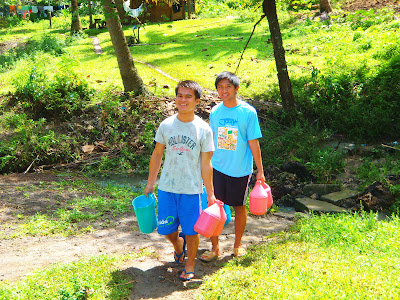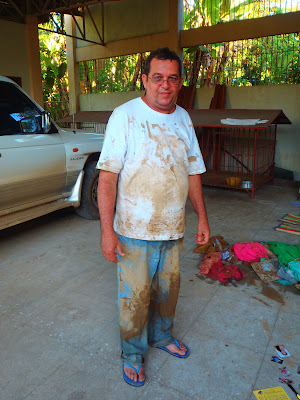 |
| Z postulantami przy kaplicy |
Druga polowa grudnia to czas “Pasko sa Bukid” w corocznym programie fomacyjnym postulantow. “Pasko sa Bukid” znaczy w Cebuano tyle co “swieta w gorach.” Postulanci jada na 10 dni w gory, gdzie zyja ludzie plemienni. Zwykle jada do jednej z kaplic w sercanskiej parfi w Dansolihon. Czas “Pasko sa Bukid” jest wyzwaniem i proba powolania dla postulantow. To pierwsze dla nich swieta spedzane poza domem rodzinnym, i to na misji.
W tym roku na misje zostala wybrana Balugha. Mala wioska, w ktorej zyje 40 rodzin i mnostwo dzieci. Wiekszosc tamtych mieszkancow to ludnosc plemienia Higaonon. Czas misji w takiej wiosce to poprostu rekolekcje adventowo-bozonarodzeniowe. Postulanci przygotowuja specjalne katechezy dla mlodziezy i dzieci, odnawiaja dzialanie kregow rodzinnych, chodza z koleda po domach I przygotowuja ‘jaselka.’ W tym roku, po raz pierwszy, Balugha miala wlasnorecznie przygotowana szopke.
 |
| Swieccy Dehonianie w Balugha |
Swoj udzial w naszej misji mieli tradycyjnie Swieccy Dehonianie. Razem z nasza przyjaciolka Grace i Evelyn, przygotowali piekne podarki i duzo pozywienia dla miejscowych ludzi. To dodalo wiele radosci podczas ‘oplatka swiatecznego’.
Misjonarze, ktorzy wlasnie wrocili z gor do domu, mimo zmeczenia, czuli wielka radosc. Wiecej bowiem otrzymali niz dali.

Second part of December is a time of “Pasko sa Bukid” in the annual program of the postulants. “Pasko sa Bukid” means ‘christmas in the maintains’. The postulants spend 10 days in the maintains with the native people. They usually go to one of the chapels in our SCJ Parish in Dansolihon.
 |
| Swiateczne pranie |
This year the mission was in Balugha. It is a very small village with 40 families and many many children. Most of the habitants are indigenous people (Higaonon). The time of mission, before and during Christmas, is like a time of retreat for that community. The postulants prepared a program for children, youth and adults in order to prepare them for Christmas. It is quite challenging for them because they live with the local people, outside of their families during the Christmas for the first time.
In the program there was a daily prayer, meetings of the small ecclesial communities, visiting houses and caroling, catechism for youth and children, nativity play, and Christmas party. For the first time in the chapel of Balugha, the people even build “belen” (crib).
The Lay Dehonians with Grace and Evelyn had also their part in the mission. They prepare many gifts and food for the local people. Everything was given to them on the Vigil of Christmas. Their offerings enriched the Christmas party of that community.
The missionaries were tired upon they arrival from the mission but also happy, at the same time. They more received than gave to them.

 |
| During "Misa de Gallo" in Balugha |
 |
| Native stars made by local people |
 |
| Kaplica w Balugha |






































